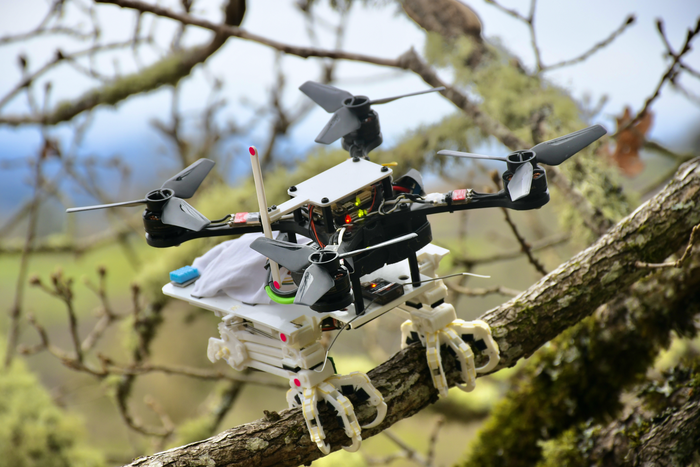Aerial drones can perform some pretty impressive feats, from high-speed dovetails to hovering almost perfectly still for long periods of time. But in terms of landing, drones have nothing on birds. Benefiting from millions of years of evolution, most birds can turn nearly anything — a branch, a telephone wire, an overpass sign — into a perching pad. Drones, in contrast, are generally limited to landing on regular surfaces.
Aiming to build more versatile flying drones, researchers have spent years studying the particular ways birds execute their graceful landing maneuvers on a wide variety of natural and artificial objects. The results have shown that, though birds can land on many different surfaces, their landing strategy typically remains the same no matter the surface.
A team of researchers recently tried to replicate that avian landing strategy in a quadcopter robot outfitted with a 3D-printed structure that mimics the grasping functions of bird legs and feet. The results were published in the journal Science Robotics.
SNAG: The bird-like drone
The bird-like drone was named SNAG, which stands for stereotyped nature-inspired aerial grasper. Why “stereotyped”? Like birds, the drone is programmed to execute the same landing sequence no matter the surface on which it will perch. The researchers outlined SNAG’s bird-inspired landing sequence:
“The legs orient toward the perch during the approach; upon impact, the collapsing legs absorb energy and passively amplify the grasping forces via a tendon differential to the feet; simultaneously, the toes conform to the surface and generate reliable friction with toe pads and stochastic forces with claws latching onto surface asperities; when the legs have fully collapsed, SNAG locks in place automatically; and SNAG balances its center of gravity over the perch.”

SNAG’s legs and feet were inspired by the peregrine falcon, a bird of prey formerly common in North America. The researchers chose this bird because of its “eye-catching grasp performance.” Like the peregrine falcon, SNAG can use its claws to grasp, carry, and even catch prey-like objects: small bean bags, tennis balls, etc.
“As in birds, SNAG’s claw geometry is sharp enough to engage with surface asperities, but not too sharp; the claws can deform compliant surfaces without penetrating them to the point of getting stuck, to ensure they release reliably,” the researchers wrote. “To release its grasp, SNAG harnesses avian-inspired elastic bands behind the toe’s joints to passively extend the toes and claws when the foot motor relaxes the leg tendon.”
The researchers also experimented with different types of bird toe arrangements, aiming to see if one proved to be particularly effective. But the results only showed minor differences, suggesting that “perching does not form an evolutionary selection pressure that can, by itself, explain arboreal avian toe diversity,” the study noted.
Revealing the complexities of avian evolution and perching strategies was only one aspect of the study. Aerial drones that function like birds also have practical aspects, namely power conservation. Because the drones are able to land on a diverse array of objects, they don’t have to hover in place while they are carrying out tasks such as environmental monitoring, search and rescue, or site inspection — all of which were listed as potential applications in the study.
The researchers concluded by suggesting improvements for future bird-like drones, such as building systems that can better select sufficient perching regions:
“…for robots to work in ‘real time’ in complex environments, we need ways to interact with the world at higher speeds with sufficient accuracy even when there is limited information about the environment. To perch reliably, these robots should act to minimize the likelihood of leaving the perching sufficiency region because the value of every point in the space is equal or ‘good enough’ for landing.”
This article was originally published in December 2021 on Big Think. It was updated in March 2022.






